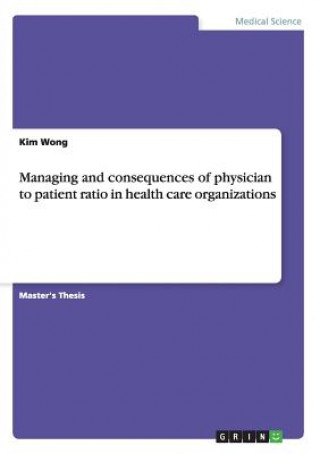
Livrare
Consilier de cumpărături





Nu se pretează? Nu contează! La noi puteți returna bunurile în 30 de zile
 Voucher cadou
orice valoare
Voucher cadou
orice valoare
Cu un voucher cadou nu veți da greș. În schimbul voucherului, destinatarul își poate alege orice din oferta noastră.
Managing and consequences of physician to patient ratio in health care organizations
 engleză
engleză
 116 b
116 b
30 de zile pentru retur bunuri
Ar putea de asemenea, să te intereseze


Master's Thesis from the year 2012 in the subject Medicine - Public Health, grade: 2,5, University of Cologne, language: English, abstract: Imbalance between demand for and supply of physicians is an issue regularly addressed by the media, researchers and policy makers. It has been widely spread in many countries for years. Healthcare organizations in both of developed and developing countries have all experienced from that. Physician to patient ratio is one of the important normative population based indicators to measure this imbalance. It equals to the entire number of physicians in a healthcare organization dividing its patient volume within a certain period (e.g., a year). The§quotient is often standardized in form of X (number of physicians) per 1,000 patients, or in form of ''1:X'' in order to express the amount of patients (X) that under one physician's management clearly. In comparison with other measurements, this kind of indicators are less complicated and easier to§comprehend. An imbalance between physician demand and supply in a healthcare organization could be explicitly identified and quantified by comparing its actual physician to patient ratio with a ''gold standard''. Unfortunately, a wide-range§suitable gold standard of physician to patient ratio does not exist. Therefore, healthcare organizations must make great efforts to find their own gold standards. The physician to patient ratio could be easily confounded with the patient to§physician ratio which represents the number of physicians, who oversee one patient within his or her entire hospital stay. In an ideal model for patient care is ''1:1'' the target patient to physician ratio to aim at. But in reality, this ratio is not§easy to realize. In this paper, merely the physician to patient ratio is under discussion.§Imbalance between demand for and supply of physicians could bring inappropriate physician to patient ratio to healthcare organizations. It is one of the major threats to healthcare organizations, as it might have consequences such as lower quality of healthcare services, closure of hospital's ward, increasing wait time, reducing number of staff beds, under-utilization of physicians or higher medical costs. Managing the physician to patient ratio is not only a key to predict these risks but also the hope for turning the imbalance situations into balance ones. [...]
Informații despre carte
 engleză
engleză




 Cum să cumpăr
Cum să cumpăr



















